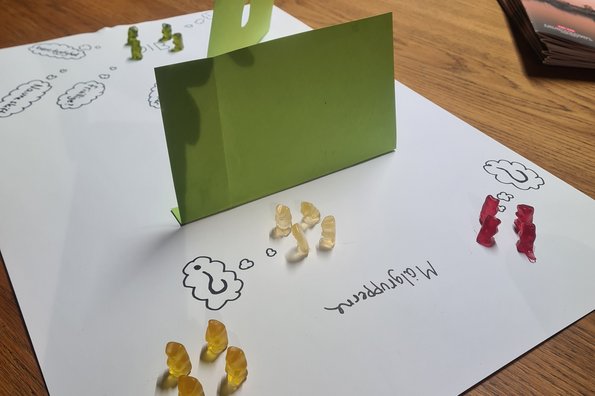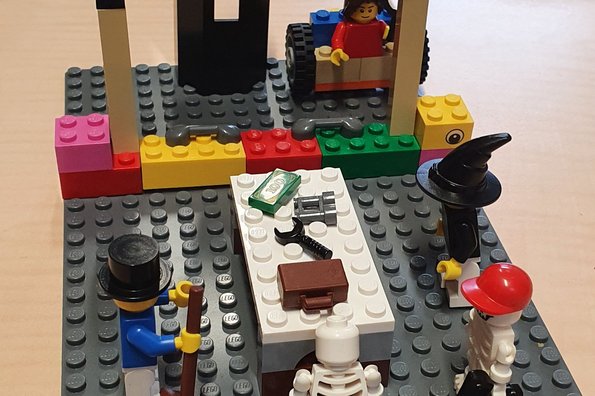Innovation and the humanities
Graduates in the humanities can create a lot of value and find plenty of new solutions for organisations and companies. A new course adopts an unorthodox approach to teach students at the Faculty of Arts how to use their expertise for innovative purposes and the creation of value.

The students are sitting around in small groups discussing ways of identifying a problem to which they have been asked to find a solution. It’s a familiar situation at any university. But on this occasion the computers and marker pens have been replaced by cardboard, glue pistols and wine gum teddy bears, and the students have been asked to produce a physical model of their case. The course is called Humanistic Innovation, and this is one of the techniques the students use to develop their new ideas.
It’s just one of a number of new teaching methods used on the course. Humanistic Innovation is a new ninth-semester course which is being offered to all Master’s students at the Faculty of Arts. Mikkel Venge, who is a professional designer, has been taken on as one of the teachers. His task is to present the students with a range of tools and methods which are normally used by design companies to develop new ideas, models and concepts.
“I’ve taught students on design programmes and engineering programmes before now, but this is the first time I’ve worked with students of the humanities. So I wasn’t sure how they’d react when they were asked to create something themselves. Would they be hesitant, or would they launch themselves into the task without a parachute and without any predefined solutions?” says Venge. In addition to his teaching, he works with sustainable product development for Holmris B8, which is Denmark’s largest supplier of furniture to companies and organisations.
“The production of physical models makes it possible to visualise relatively complex issues, helping to study them in greater depth. For instance, such models help to reveal the different perspectives of employees, customers and employers. So one of the challenges facing the students on the course has involved producing primitive prototypes with glue pistols, cardboard and wine gum teddy bears under a certain amount of time pressure. The aim is to make it impossible to create something which is aesthetically pleasing. And once you remove that factor from the equation, you can focus fully on the actual function of the model you’re trying to produce. You simply can’t produce anything that will look good and impress other people, and the students really like working in this way,” says Venge.
The fear of not being creative
It might seem strange to be working with cardboard and wine gums, or with LEGO blocks and figures, but it’s actually a serious affair – and the technique is also based on research, explains Michael Mose Biskjær. He’s an associate professor of design creativity and innovation at the School of Communication and Culture at Aarhus University, and he’s responsible for the course.
“The technique removes any fear of not being creative enough. It removes all the extraneous factors, enabling the students to focus purely on ideas and the clarity of their thoughts. Producing a physical model of your reasoning makes it harder to explain away any of the potential weaknesses in your argument,” explains Biskjær. He points out that the focus in the humanities is often placed on language and texts – so the students have to use their brains a lot. But you can also learn a lot by using your hands.
“Working with tangible objects influences the way you think. It also changes the way students work together to produce innovative concepts for solutions. When they are placed in groups and asked to produce something tangible to visualise their ideas, and when they are given the tools and objects needed to achieve this task, the creative processes in which they are engaged change too.”
Innovation based on expertise from the humanities
The course seeks to utilise the humanistic expertise of the students and show them that they can create value for other people by using this expertise, explains Biskjær.
“One of the things that we challenge on this course is the notion that innovation and value creation depend purely on growth, key figures and the financial bottom line. But value can also be created in other ways. In the form of social and cultural value, for instance. We’ve learned that working with a broad concept of value creation appeals to students of the humanities who are keen to make a difference and use their expertise to leave a tangible mark on the world,” says Biskjær.
The problem for many humanities graduates is that their special expertise is only a perfect match for relatively few jobs on the labour market. On the other hand, it seems unreasonable that our graduates are forced to compete for jobs as generalists after spending many years studying a specific subject and becoming specialists, explains Biskjær.
“The Humanistic Innovation course seeks to focus on the basic skills possessed by humanities graduates. They are experts at analysing, interpreting, discussing, presenting arguments, acquiring knowledge and communicating. The aim is to employ these skills to actually create something valuable in relation to complex, concrete issues with the focus on human problems,” says Biskjær.
A reality check
On the course the students meet a variety of organisations and institutions as well as established and start-up companies, and they are also presented with a variety of cases. It’s like a reality check. The third teacher on the course, Pia Storvang, who is a part-time lecturer in design management, also introduces the students to innovation and project management. The aim is to ensure that the creative process has a structure, and to create new insights into the stakeholders and the issues facing them as a precondition for value-creating innovation in individual cases.
In the autumn of 2022, the course focused on three cases: a major AU research project called SHAPE dealing with citizen inclusion and digitalisation; a small start-up company linked to The Kitchen (AU’s start-up hub) which has developed a new system for registering working hours in cafes and other small businesses; and finally a small development organisation whose purpose is to promote sustainable settlement in the third world.
Two different groups of students are involved in each case, working with a joint issue which is presented at the start of the semester. However, the point is that all the cases chosen have a perspective which extends beyond presenting proposed solutions for specific organisations or companies. The cases represent examples of the kind of complicated issues that the students may also encounter after they graduate from university.
“For instance, the idealistic institutions and associations involved in development work, social work and environmental issues often face the same kind of challenges when it comes to attracting and engaging new members and voluntary activists. They are facing the same kind of pressure as other voluntary and recreational clubs and associations in the rest of Denmark. One of the quick fixes they can resort to involves strengthening their presence on social media and collecting loads of “likes”. But this doesn’t help the organisation in the long run, because the problem will pop up again three months later,” says Michael Mose Biskjær. And he continues:
“The students are asked to help develop ideas and concepts which focus instead on creating lasting changes and long-term value. You can always launch new campaigns for organisations, associations, institutions or companies. They can improve the way they brand themselves on Instagram, for instance. But that’s not innovation. That’s just marketing.”
The world outside the ivory tower
The positive spirit in which this innovative approach to the teaching has been received shines through when you talk to the students at a workshop in The Kitchen and ask them for feedback on their experiences so far.
“We think this course is the best thing that has ever happened to us at the university. It’s often difficult to define what kind of skills you have, and what you can offer the world outside the ivory tower. But this course provides us with specific methods of doing this which haven’t been presented to us at the university until now,” says Celina Rosleff, who is a Master’s student of Scandinavian languages and literature.
She is working on a case in which the students explore ways of improving wellbeing in the workplace, trying to make working at cafes and small businesses more attractive by developing a staff system that resembles Trustpilot, based on an existing system for registering working hours.
“Our teachers manage to keep the teaching relevant, bearing in mind that we have to deal with the real world after we graduate from university. We learn how to stand out on the labour market, and how to define ways in which humanities graduates can help to generate value,” explains Rosleff.
Her fellow student Cecilie Nielsen agrees. Her case focuses on generating greater commitment among volunteers and more support for a small NGO which works with development problems in the third world.
“We’re not used to working closely with a company. Normally we spend our time studying texts to find out what various theoreticians have said about a given issue. But now we actually attend meetings with organisations and companies which provide us with input – and they want to hear what we have to say, as well. It’s a totally different feeling: someone out there is taking you seriously, and you feel that the things you produce will actually be used for a practical purpose. It’s really cool,” says Nielsen.
LinkedIn was founded by a philosopher
Michael Mose Biskjær points out that there is a need to challenge the prejudices associated with being a graduate of the humanities, and that a course like Humanistic Innovation is one way of doing this.
“Humanities graduates are often described as people who only create knowledge for the sake of knowledge itself, the idea being that growth can only be created by the business community, entrepreneurs and others. But this is a major misunderstanding. There are plenty of humanities graduates who have created flourishing companies based on their special expertise and their ability to create new knowledge. It’s simply not true to say that graduates in the humanities can’t create growth,” says Biskjær.
He points out that GoMore, Denmark’s largest site for private car rental, leasing and car sharing, was founded by two philosophers: Matias Møl Dalsgaard and Søren Riis. LinkedIn is another example. More than 2.5 million Danes have a profile on LinkedIn, making it the second-largest social network in Denmark after Facebook. But few people know that LinkedIn wasn’t founded by computer science entrepreneurs or financial gurus – it was founded by a humanities graduate.
“The founder of LinkedIn, Reid Hoffman, who is now one of the most influential individuals in Silicon Valley, has a Master’s degree in philosophy from the University of Oxford. And he has often said that his background in the humanities is what enabled him to create LinkedIn. If we fail to recognise the knowledge and skills that humanities graduates can bring to the table, and if we fail to give them opportunities to show what they can do, society will be losing out on a wealth of innovation and growth potential.”
Further information
You can read more about Humanistic Innovation on the course website here:




